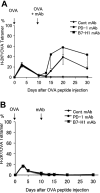Interaction between B7-H1 and PD-1 determines initiation and reversal of T-cell anergy
- PMID: 17289811
- PMCID: PMC1896111
- DOI: 10.1182/blood-2006-11-060087
Interaction between B7-H1 and PD-1 determines initiation and reversal of T-cell anergy
Abstract
Although self-reactive T-cell precursors can be eliminated upon recognition of self-antigen presented in the thymus, this central tolerance process is often incomplete, and additional mechanisms are required to prevent autoimmunity. Recent studies indicates that the interaction between B7-H1 and its receptor PD-1 on activated T cells plays an important role in the inhibition of T-cell responses in peripheral organs. Here, we show that, before their exit to the periphery, T cells in lymphoid organs rapidly up-regulate PD-1 upon tolerogen recognition. Ablation of the B7-H1 and PD-1 interaction when T cells are still in lymphoid organs prevents anergy. Furthermore, blockade of B7-H1 and PD-1 interaction could render anergic T cells responsive to antigen. Our results thus reveal previously unappreciated roles of B7-H1 and PD-1 interaction in the control of initiation and reversion of T-cell anergy.
Figures





Similar articles
-
B7-H1 expression on non-B and non-T cells promotes distinct effects on T- and B-cell responses in autoimmune arthritis.Eur J Immunol. 2010 Nov;40(11):3117-27. doi: 10.1002/eji.201040690. Epub 2010 Oct 27. Eur J Immunol. 2010. PMID: 21061440 Free PMC article.
-
Cutting Edge: Programmed death (PD) ligand-1/PD-1 interaction is required for CD8+ T cell tolerance to tissue antigens.J Immunol. 2006 Dec 15;177(12):8291-5. doi: 10.4049/jimmunol.177.12.8291. J Immunol. 2006. PMID: 17142723
-
PD-1 ligands expressed on myeloid-derived APC in the CNS regulate T-cell responses in EAE.Eur J Immunol. 2008 Oct;38(10):2706-17. doi: 10.1002/eji.200838137. Eur J Immunol. 2008. PMID: 18825752 Free PMC article.
-
Interaction of PD-L1 on tumor cells with PD-1 on tumor-specific T cells as a mechanism of immune evasion: implications for tumor immunotherapy.Cancer Immunol Immunother. 2005 Apr;54(4):307-14. doi: 10.1007/s00262-004-0593-x. Epub 2004 Dec 15. Cancer Immunol Immunother. 2005. PMID: 15599732 Free PMC article. Review.
-
Control of peripheral T-cell tolerance and autoimmunity via the CTLA-4 and PD-1 pathways.Immunol Rev. 2008 Aug;224:166-82. doi: 10.1111/j.1600-065X.2008.00662.x. Immunol Rev. 2008. PMID: 18759926 Review.
Cited by
-
Hydrogel dual delivered celecoxib and anti-PD-1 synergistically improve antitumor immunity.Oncoimmunology. 2015 Aug 12;5(2):e1074374. doi: 10.1080/2162402X.2015.1074374. eCollection 2016 Feb. Oncoimmunology. 2015. PMID: 27057439 Free PMC article.
-
Lymphatic endothelial cells induce tolerance via PD-L1 and lack of costimulation leading to high-level PD-1 expression on CD8 T cells.Blood. 2012 Dec 6;120(24):4772-82. doi: 10.1182/blood-2012-04-427013. Epub 2012 Sep 19. Blood. 2012. PMID: 22993390 Free PMC article.
-
Novel strategies for immunotherapy in multiple myeloma: previous experience and future directions.Clin Dev Immunol. 2012;2012:753407. doi: 10.1155/2012/753407. Epub 2012 May 10. Clin Dev Immunol. 2012. PMID: 22649466 Free PMC article. Review.
-
Advances in targeting cell surface signalling molecules for immune modulation.Nat Rev Drug Discov. 2013 Feb;12(2):130-46. doi: 10.1038/nrd3877. Nat Rev Drug Discov. 2013. PMID: 23370250 Free PMC article. Review.
-
The programmed death-1 immune-suppressive pathway: barrier to antitumor immunity.J Immunol. 2014 Oct 15;193(8):3835-41. doi: 10.4049/jimmunol.1401572. J Immunol. 2014. PMID: 25281753 Free PMC article. Review.
References
-
- Chen L. Co-inhibitory molecules of the B7-CD28 family in the control of T-cell immunity. Nature Rev Immunol. 2004;4:336–347. - PubMed
-
- Greenwald RJ, Freeman GJ, Sharpe AH. The B7 family revisited. Annu Rev Immunol. 2005;23:515–548. - PubMed
-
- Agata Y, Kawasaki A, Nishimura H, et al. Expression of the PD-1 antigen on the surface of stimulated mouse T and B lymphocytes. Int Immunol. 1996;8:765–772. - PubMed
-
- Nishimura H, Nose M, Hiai H, Minato N, Honjo T. Development of lupus-like autoimmune diseases by disruption of the PD-1 gene encoding an ITIM motif-carrying immunoreceptor. Immunity. 1999;11:141–151. - PubMed
Publication types
MeSH terms
Substances
Grants and funding
LinkOut - more resources
Full Text Sources
Other Literature Sources
Research Materials

